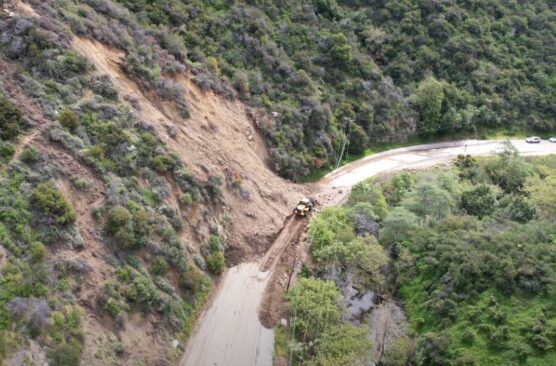Topanga Canyon Boulevard/State Route 27 is set to reopen on Sunday, June 2, after being shut down due to a 9 million-pound landslide.
The scenic road connecting Malibu to the western San Fernando Valley in Los Angeles was originally scheduled to reopen in the fall.
Topanga Canyon Boulevard closed on March 9 after storms brough heavy rain and high winds to the area, causing the hillside to slide onto the highway. The unstable conditions of the slope also prevented crews from doing work on clearing the area.
The blockage caused major headaches for many residents in the community of Topanga, which faced hours-long detours and the loss of revenue to local businesses.
The closure of the road also impacted drivers throughout the region, including those from the Santa Clarita and Simi Valleys that regularly use the road to travel to the Pacific Coast Highway/State Route 1.
“I cannot overstate just how important it has been for the state and everyone involved to see Topanga Canyon Boulevard open as quickly and as safely as possible. Thanks to the diligent efforts by the state along with crews assisting on the ground and the support of locals, this repair work has exceeded all our expectations by opening months ahead of initial estimates,” said Governor Gavin Newsom.
Approximately 15,000 cubic yards of material has been removed and repurposed for Ventura County farmers, the Los Angeles County Department of Public Works and an art installation in downtown Los Angeles near the State Historic Park. Caltrans revised its original estimate of 50,000 to 90,000 cubic yards of material needing to be removed once a geotechnical report determined that the slide was shallower than first thought. Crews did not encounter any anomalies in the soil during removal, which benefited the expedited opening.
“The incredible work of Caltrans geotechnical and construction engineers and geologists and the contractor has returned a vital connection for this community,” said Caltrans Director Tony Tavares.
To remove materials, crews built an access road adjacent to the slide to push down materials from the top using a Spider Excavator and loading the materials into Super-10 trucks with a long-reach excavator. From there, the trucks hauled the dirt and rocks to the farms, county storage locations and the art installation.
Now that Caltrans has stabilized the slope and removed material, geotechnical engineers and geologists will monitor the site for any movement. They may recommend a cable mesh drapery system to prevent any sloughing of remaining loose materials and planting native seeds to further stabilize the slope.
Like this:
Like Loading...
Related





 Tweet This
Tweet This Facebook
Facebook Digg This
Digg This Bookmark
Bookmark Stumble
Stumble RSS
RSS




























REAL NAMES ONLY: All posters must use their real individual or business name. This applies equally to Twitter account holders who use a nickname.
0 Comments
You can be the first one to leave a comment.